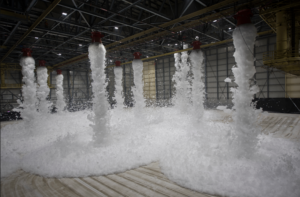PFAS in firefighting foam linked to testicular cancer in new study
A study of over 1,000 Air Force servicemen shows that exposure to firefighting foam containing PFAS may be linked to a higher risk of developing testicular cancer.
The research, led by scientists from the National Institutes of Health (NIH), a federally funded research center, adds to a collection of scientific work investigating the links between certain kinds of PFAS and a range of human health harms.
The new study specifically looked at PFAS as an ingredient in aqueous film-forming foams (AFFFs) used on military bases, and analyzed PFAS exposures of Air Force servicemen who worked regularly with AFFF for years.
The findings may give new credence to mounting lawsuits from military veterans claiming PFAS exposure in firefighting foam made them sick while manufacturers hid the health risks. Thousands of other lawsuits are pending against PFAS manufacturers 3M and DuPont, among other companies, alleging they spread harmful PFAS throughout the environment despite knowing of risks to human health.
“We were still under the perception that firefighting foam was safe,” said Kevin Ferrara, a retired former Air Force firefighter who used AFFFs on a regular basis for 15 years during his military career. While Ferrara has never had testicular cancer, he suffers from other health issues he believes are linked to PFAS exposure. He says that no one ever told him or his colleagues that the firefighting foam might have posed a health risk, and they didn’t usually take extra precautions to avoid direct contact with the foam.
“Now we know the truth,” he said.
Elevated rates of multiple cancers have been found among people exposed to the firefighting foams. PFAS has also been linked to kidney and prostate cancer, liver dysfunction, high cholesterol, and reproductive problems.
Used for decades
PFAS, the acronym for per- and polyfluoroalkyl substances, are a group of chemicals that have been widely used for decades around the world in an array of industrial processes and consumer products for their thermal stability and stain- and water-repellent properties. They are present in pizza boxes, plastics, paints and thousands of other products. PFAS have also been widely used at military bases and airports.
As public knowledge of human and environmental harm associated with certain types of PFAS has grown, state and federal officials have moved to reduce their use and attempt to clean up PFAS contaminated areas, including drinking water supplies around the country, which are known to be contaminated with PFAS.
The Environmental Protection Agency (EPA) has proposed designating certain types of PFAS, including perfluorooctanoic acid (PFOA) and perfluorooctane sulfonic acid (PFOS), as hazardous substances, a move sparking outcry from industries around the US.
The EPA acknowledges that peer-reviewed studies show that PFAS exposure may increase the risk of several cancers, including testicular, but says that health effects of PFAS are generally difficult to specify. Because there are thousands of different PFAS chemicals that virtually all people are exposed to at different stages of their lives, it’s difficult for scientists to pinpoint exactly which PFAS, and which PFAS doses, cause particular forms of cancer, according to the EPA.

The US Air Force has been using AFFF containing PFAS since the 1960s. Though the Department of Defense (DOD) now intends to phase out the use of AFFFs by October 1, 2024, military bases continue to be hotspots of PFAS pollution due to AFFF ingredients seeping into the water supply. At least 3,493 military sites in the US are thought to have PFAS-contaminated water, according to research published last year.
More research needed
In the new study, NIH researchers analyzed blood samples from 1,060 Air Force servicemen, half of whom had developed testicular tumor cells after they finished serving. They found that the servicemen with higher exposures to PFOS were more likely to have developed testicular cancer.
The study did not find a link between PFOA and testicular cancer, however, though previous research has linked PFOA to testicular cancer found in workers and nearby residents at a chemical manufacturing plant run by DuPont.
Only limited evidence exists linking PFAS to testicular cancer, according to a recently-published commentary by Kyle Steenland, a professor of epidemiology at Emory University. This evidence includes a study done at a highly contaminated site in Sweden, which showed a higher, but not statistically significant, increase in testicular cancer risk among those with the highest PFAS exposures.
Studying the environmental causes of cancer is notoriously difficult due to the length of time between environmental exposures and disease diagnosis, as well as the many factors that contribute to someone’s health. “In summary, more studies are needed, as is almost always the case for environmental chemicals,” wrote Steenland.
David Savitz, a professor of epidemiology at Brown University who was not involved in the new research, said the existing evidence does not currently make a clear and compelling case tying testicular cancer to PFAS.
However, there’s still enough evidence that PFAS cause harmful health effects to justify limiting the public’s exposure, he said, citing research showing PFAS exposure contributes to elevated cholesterol levels, impaired immune systems, and liver dysfunction.
“Do elevated levels pose a health hazard? I think the answer is yes,” Savitz said.
(Featured image: Master Sgt. David Clifford washes off firefighting foam after battling a two-alarm fire on July 22, 2008 at Joint Base Balad, Iraq. Credit: U.S. Army photo/Sgt. Gary Hawkins)



